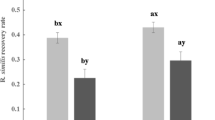Abstract
Two field experiments were carried out in a clay-loam soil to determine whether damage caused by root-knot nematode on ginger could be reduced by crop rotation and organic amendments, rather than with nematicides. When early-harvest ginger was grown for three successive years, root-knot nematode populations remained low and caused no damage in the first crop, which followed two years of green panic (Panicum maximum). Nematode damage was observed in the second and third crop, but the severity of symptoms on rhizomes was reduced by amendments containing poultry manure and/or sawdust. However, the best control was achieved with a nematicide program involving pre-plant fumigation with ethylene dibromide and post-plant sprays of fenamiphos. In a second experiment, late-harvest ginger was grown every second year, with a green manure crop in the intervening year. Populations of root-knot nematode were lower following forage sorghum (Sorghum bicolor × sudanense) cv. Jumbo than following lablab (Lablab purpureus) cv. Highworth. However, when ginger followed either crop and amendments of poultry manure and/or sawdust were also applied, nematode damage was negligible. These results suggest that rootknot nematode on ginger can be controlled by alternating ginger with a green manure crop and applying at least 150 m3/ha/annum of poultry manure, with or without additional sawdust. When ginger is grown in successive years, nematode populations increase to high densities despite the use of organic amendments, so that nematicides are needed to achieve satisfactory control.
Similar content being viewed by others
References
Colbran, R.C. (1974) — Nematode control in ginger with nematicides, selection of planting material and sawdust mulch. Queensland Journal of Agricultura1 and Animal Sciences 31: 231–235.
Colbran, R.C. and Davis, J.J. (1969) — Studies of hot-water treatment and soil fumigation for control of root knot in ginger. Queensland Journal of Agricultura1 and Animal Sciences 26: 439–445.
Rodriguez-Kabana, R. (1986) — Organic and inorganic nitrogen amendments to soil as nematode suppressants. Journal of Nematology 18: 129–135.
Stirling, A.M., Stirling, G.R. and Macrae, I.C. (1992) — Microbial degradation of fenamiphos after repeated application to a tomato growing soil. Nematologica 38: 245–254.
Stirling, G.R. (1989) — Organic amendments for control of root-knot nematode (Meloidowe incognita) on ginger. Australasian Plant Pathology 18: 39–44.
Thomason, I.J. (1987) — Challenges facing nematology: environmental risks with nematicides and the need for new approaches. In Vitas on Nematology (Eds J.A. Veech and D.W. Dickson), pp. 469–476, Society of Nematologists, Hyattsville, Md, USA.
Whitehead, A.G. and Hemming, J.R. (1965) — A comparison of some quantitative methods of extracting small vermiform nematodes from soil. Annals of applied Biology 55: 25–38.
Author information
Authors and Affiliations
Corresponding author
Rights and permissions
About this article
Cite this article
Stirling, G.R., Nikulin, A. Crop rotation, organic amendments and nematicides for control of root-knot nematodes (Meloidogyne incognita) on ginger. Australasian Plant Pathology 27, 234–243 (1998). https://doi.org/10.1071/AP98026
Received:
Accepted:
Issue Date:
DOI: https://doi.org/10.1071/AP98026




